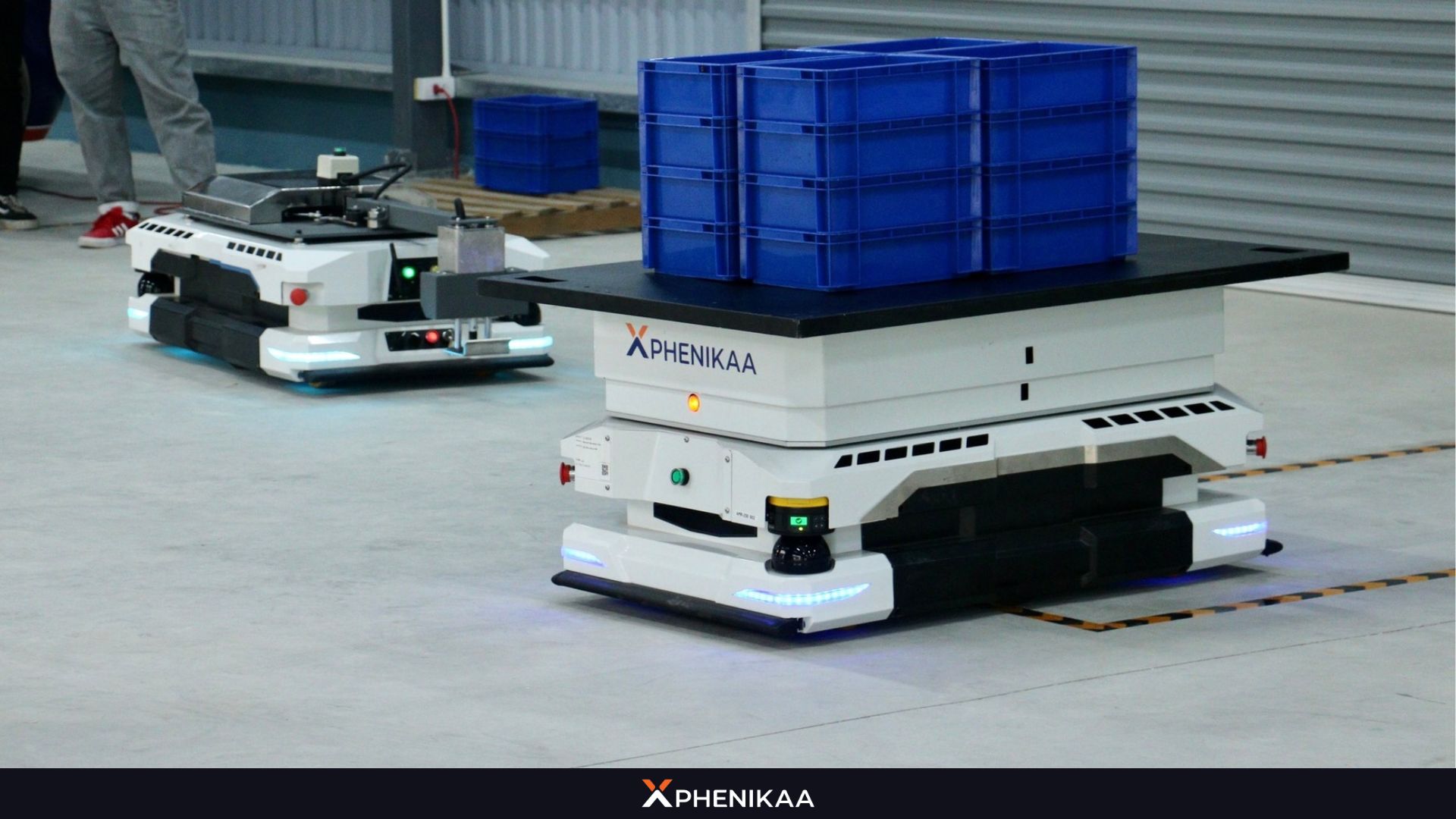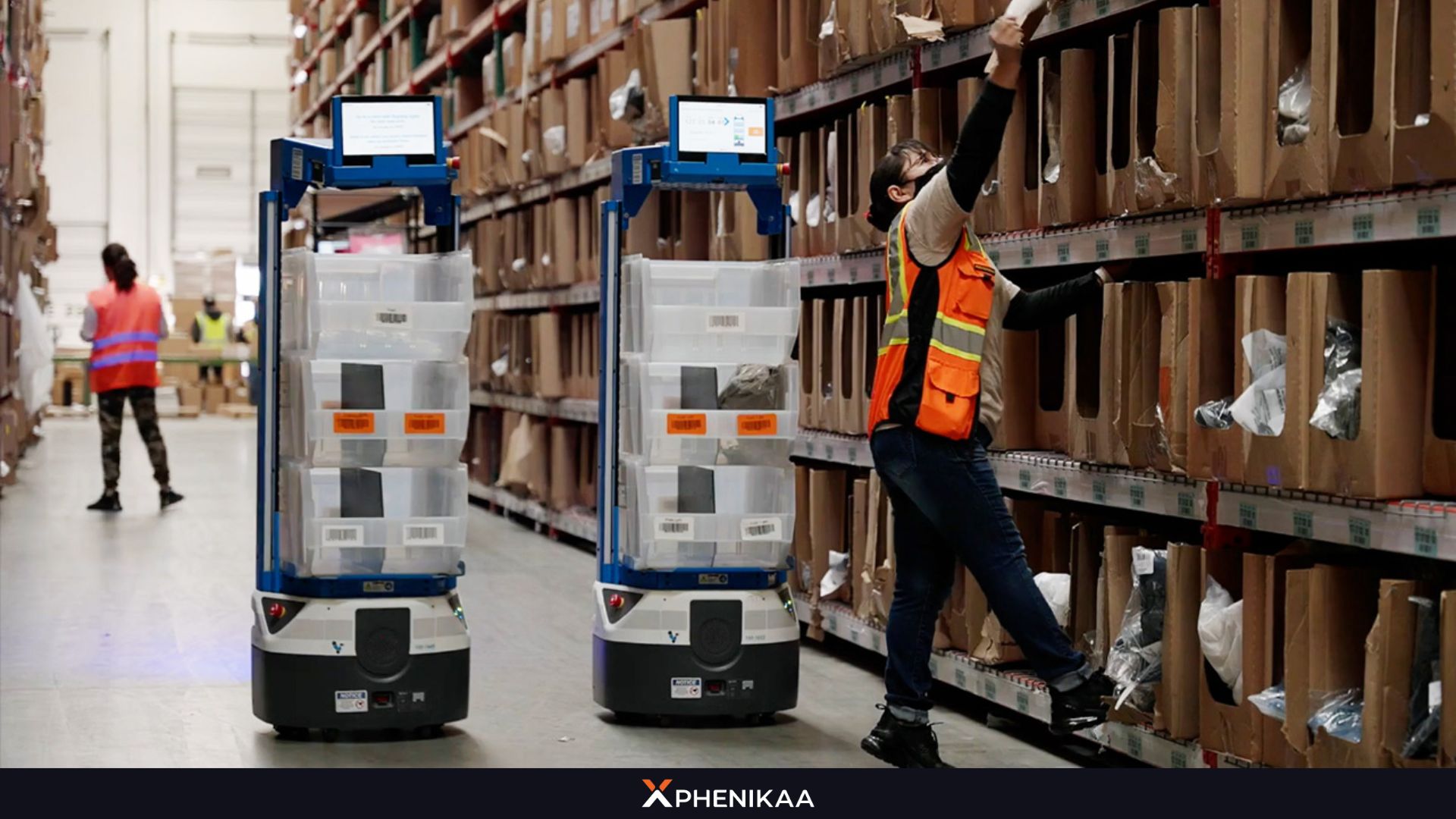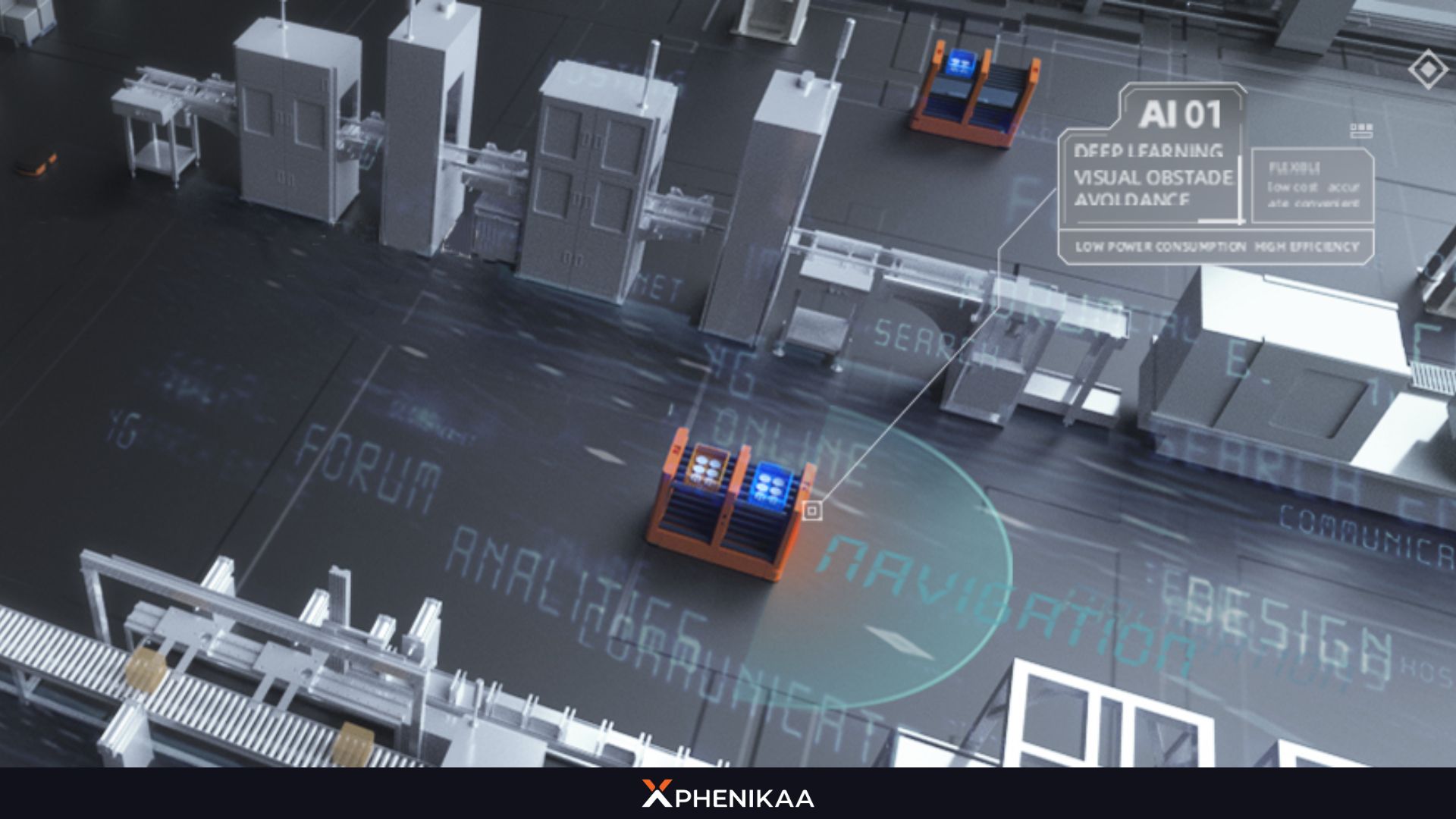The synergy between humans and AMR robots is ushering in a new era of productivity and efficiency, offering optimal solutions for numerous industries. Phenikaa-X pioneers in creating a harmonious work environment where technology and humans collaborate, enhancing performance and delivering exceptional benefits. These collaborative solutions are reshaping the future of automation and operational optimization.
1. How Do Humans Effectively Collaborate With AMRs?
Humans effectively collaborate with AMRs through three main approaches: complementary task support, flexible monitoring and control, and continuous learning and improvement, creating a dynamic and intelligent work ecosystem.
In the 4.0 era, the intersection of humans and technology, especially with AMR, is becoming a key factor in boosting productivity and optimizing processes. AMRs, with their flexible movement and self-routing capabilities in complex environments, are gradually replacing fixed conveyor systems and traditional forklifts, bringing superior efficiency. Here are three ways humans can effectively collaborate with AMRs, along with specific examples and data to illustrate.
Brief introduction about the AMR
Autonomous Mobile Robots (AMRs) are intelligent automated devices used to support workers in manufacturing and warehousing. Their primary function is to transport goods, ensuring smooth flow between stages of the production process. Equipped with advanced AI technology and modern sensors like LiDAR and 3D cameras, AMRs can navigate autonomously, avoiding collisions with obstacles or people, thus ensuring a high level of safety in the workplace.

Unlike traditional robots that require human control to operate, AMR can perform assigned tasks entirely autonomously. Leveraging this strength, major companies such as Amazon, Alibaba and Samsung have integrated AMR into their production processes to boost productivity and operational efficiency. AMR do not fully replace humans but foster Human-AMR Collaboration, assisting workers in transporting heavy loads, reducing physical strain, and enhancing labor efficiency in factories and warehouses.
Here are three ways humans can effectively collaborate with AMRs, along with specific examples and data to illustrate.
1.1. How Do AMRs Complement Human Tasks?
AMRs support humans by handling repetitive, strenuous, or dangerous tasks, freeing up human labor and allowing people to focus on jobs requiring skill, creativity, and complex decision-making.
This collaboration leverages the strengths of both humans and robots. AMRs excel at tasks requiring high precision, repeatability, and the ability to handle large volumes, while humans are strong in adaptability, complex problem-solving, and social interaction. This combination creates a powerful value chain, minimizing errors and enhancing overall performance.
How exactly can AMR help people in reality? In the logistics industry, transporting goods from one area to another often takes a lot of time and effort from employees. A study shows that companies using AMRs in warehouses can reduce worker travel time by up to 50%, while increasing order processing capability by 30%. Phenikaa-X provides AMR solutions that completely automate the transport of raw materials in electronics manufacturing plants, minimizing the risk of injury for employees from lifting heavy objects.

For instance, an APM – Forklift AMR can transport pallets of components weighing 200 – 1000kg from the production line to the packaging area without direct human intervention, completing 50 trips per 8-hour shift. This not only protects worker health but also accelerates goods circulation. Employees can focus on quality control, process monitoring, or tasks requiring dexterity and critical thinking. This application clearly demonstrates human AMR collaboration.
Here are some data we researched about AMR supporting workforce worldwide:
- According to Interact Analysis’s 2023 report, the global AMR market is projected to reach 18 billion USD by 2027, with a Compound Annual Growth Rate (CAGR) of 30%. This growth is largely driven by the demand to optimize workflows and reduce labor costs.
- In Vietnam, a warehouse normally using 10 AMRs for goods transport can save an average of 2,500 manual labor hours per month, equivalent to reducing 1.5 full-time employees. With an average salary of 8 million VND/month, this could save approximately 12 million VND/month in direct personnel costs.
- Based on the research from questionnaire Phenikaa-X’s partners, AMRs boost to reduce human errors. For example, in an assembly plant, the error rate can drop from 2% to 0.5% when AMRs handle part movement and positioning, leading to savings in repair costs and waste of up to hundreds of millions of VND annually.
1.2. How Do Humans Flexibly Monitor and Control AMRs?
Humans flexibly monitor and control AMRs through intuitive interfaces, allowing them to manage, reprogram tasks, or intervene when necessary, ensuring smooth and safe operations in all situations.
While AMRs operate autonomously, operator monitoring and control are crucial for ensuring safety, efficiency, and adaptability. Humans can set routes, operating zones, and adjust AMR operating parameters through central management systems. This is especially important in emergency situations or when there are sudden changes in the work environment.
In a large warehouse, an operator can use management software to monitor the location and status of dozens of AMRs simultaneously. If an AMR encounters an unexpected obstacle or needs to prioritize an urgent task, the employee can adjust the route or reassign the task remotely.
Phenikaa-X has implemented an AMR management system at a large seaport in Hai Phong, where container-transporting robots can be controlled and monitored via a central dashboard. When a ship docks, operators can prioritize AMRs to quickly reach unloading positions, reducing vessel waiting times, estimated to save 15-20% in docking costs. This human AMR collaboration capability significantly enhances port operating efficiency.

Table illustrating AMR monitoring and control features:
| Feature | Description | Benefit |
| Real-time location monitoring | Displays the precise location of each AMR on a digital map. | Ensures AMRs follow correct routes, avoiding congestion. |
| Dynamic task programming | Changes AMR tasks and routes instantly as required. | Increases flexibility and responsiveness to changes. |
| Alerts and troubleshooting | System automatically reports incidents (e.g., low battery, blockage). | Minimizes downtime, optimizes operations. |
| Performance analysis | Provides data on distance traveled, operating time. | Supports decision-making for process improvement. |
These control systems help humans maintain full oversight, ensuring that AMRs operate according to business objectives and safety regulations. Statistics from a 2022 Robotics Business Review survey show that human intervention helped resolve complex situations that robots could not handle autonomously, which was done by having a dedicated operator monitoring them.
1.3. How Do Humans Continuously Learn and Improve with AMRs?
Humans continuously learn and improve with AMRs by analyzing robot operational data, making process adjustments, and retraining the system to enhance long-term performance and adaptability.
The human-AMR collaboration relationship goes beyond task assignment or monitoring. It is a process of continuous learning and improvement. Humans can collect and analyze data from AMR operations to identify bottlenecks, optimize routes, and improve workflows. Conversely, AMRs can be updated with software and algorithms to adapt to new requirements, leading to higher efficiency.
For example: An automotive manufacturing plant uses AMRs to move large parts between assembly stations. Initially, AMRs were programmed with fixed routes. However, after analyzing operational data for 3 months, the engineering team discovered that some peak hours often saw congestion due to human activity on these routes. They adjusted the AMR algorithm to allow robots to automatically seek alternative routes during peak hours, reducing average transport time by 15%, equivalent to 10 minutes per trip.

This helps increase production by 5% daily, equivalent to about 20 additional cars per month. Phenikaa-X regularly organizes training sessions for employees on how to analyze AMR operational data, thereby proposing improvement suggestions. For instance, at a distribution center, after analyzing human-AMR collaboration performance of said facility’s data over 6 months, engineers refined the navigation algorithm, which helped reduce AMR energy consumption by 10% and increased task completion speed by 5%.
Continuous improvement process with AMRs:
- Data collection: AMRs are equipped with sensors to collect data on environment, speed, distance traveled, task completion time, and incidents.
- Data analysis: Humans use data analytics tools to identify trends, weaknesses, and improvement opportunities.
- Adjustment and optimization: Based on analysis, AMR algorithms are fine-tuned, routes are optimized, or workflows are changed.
- Training and upgrades: New software versions are deployed, and employees are trained to effectively use new features.
2. What Are The Practical Benefits of Human-AMR Collaboration?
Human-AMR collaboration delivers numerous superior benefits, including increased labor productivity, reduced operational costs, improved workplace safety, and the creation of a smarter work environment, thereby optimizing overall business efficiency.
This combination is not just a technological trend but also an effective business strategy. It helps businesses overcome challenges such as labor shortages, competitive pressure, and increasing demands for performance. Phenikaa-X recognizes that organizations strategically integrating AMRs will gain a significant competitive advantage. This also relates to concepts of human AMR collaboration and mobile robotics.
2.1. How Does AMR Collaboration Improve Labor Productivity?
AMR collaboration improves productivity by automating repetitive tasks and transportation, allowing employees to focus on higher-value work, reducing downtime, and optimizing workflows.
When AMRs handle transportation tasks, humans can dedicate more time to duties requiring skill, creativity, and interaction. This not only increases efficiency but also enhances employee job satisfaction.
Specific data:
- According to a study by MHI (Material Handling Institute), warehouses utilizing AMRs can increase productivity by 25-35% compared to traditional warehouses.
- In manufacturing, using AMRs to supply components to assembly lines can reduce material waiting times by 20%, helping to increase overall plant output.
- The Vietnam National Productivity Institute (VNPI) estimates that applying automation technologies like AMRs can help Vietnamese businesses increase labor productivity by an additional 15% within the next 5 years. Phenikaa-X is proud to be a pioneer in providing AMR solutions that meet international standards and are suitable for Vietnam’s specific production needs, contributing to the overall productivity of the economy.

2.2. How Does AMR Collaboration Reduce Operational Costs?
AMR collaboration reduces operational costs by optimizing warehouse space utilization, minimizing labor costs for repetitive tasks, and reducing goods damage through more precise and safer transportation.
Initial investment in AMRs can be substantial, but in the long run, they offer significant economic efficiency through cuts in labor costs, space optimization, and reduced goods damage. This represents a sustainable investment for the future.
Here are some cost savings calculation based on the data we collect from our partners:
- Assume a large warehouse requires 10 employees for goods transport, each with an average salary of 8 million VND/month (approximately $326 USD/month, excluding other insurance and benefit costs). Total monthly labor cost is 80 million VND ($3,265 USD).
- When deploying 5 AMRs capable of replacing 80% of the work of those 10 employees, only 2 employees are needed for supervision. The initial investment cost for 5 AMRs is approximately 3-5 billion VND ($122,449–$204,082 USD, depending on AMR type and features). AMR operating and maintenance costs are estimated at about 10-15% of the initial investment value annually, equivalent to 300–750 million VND/year ($30,612 USD/year).
- Total labor costs decrease to 16 million VND/month ($653 USD/month for 2 employees). This saves 64 million VND/month ($2,612 USD/month) in direct labor costs.
- With these savings, the Return on Investment (ROI) for AMRs can range from 3 to 5 years, depending on the scale and degree of automation.
Additionally, AMRs can operate 24/7 without rest, increasing asset utilization efficiency and reducing electricity costs due to optimized routing. They also help reduce goods damage rates by up to 80% compared to manual transport methods, lowering compensation and waste costs. Phenikaa-X’s solutions are designed to optimize costs and provide rapid investment returns for businesses, serving as a testament to the success of a fully automated facility.
2.3. How Do AMRs Improve Workplace Safety and Environment?
AMRs improve workplace safety by eliminating dangerous or strenuous tasks for humans, reducing accident risks due to collisions, and creating a less stressful work environment.
AMR safety is always a top priority in any work environment. The Robots, with their ability to self-localize, avoid obstacles, and adhere to strict safety regulations, significantly reduce the risk of workplace accidents related to material transport. This brings peace of mind to workers and minimizes accident-related costs for businesses.
Safety statistics:
- According to the Department of Work Safety (Ministry of Labor, Invalids and Social Affairs), thousands of workplace accidents related to forklifts and manual transport occur annually in Vietnam.
- International studies indicate that deploying AMRs can reduce material transport-related workplace accidents by 70-80% due to advanced collision avoidance capabilities and their inability to experience fatigue like humans.
- Phenikaa-X designs AMRs with modern LiDAR sensors and 3D cameras, enabling robots to detect obstacles and pedestrians from a distance of 10m, automatically slowing down or stopping to avoid collisions. This significantly reduces the risk of accidents in factory environments, creating a safer workplace for everyone.

The presence of AMRs reduces physical strain on employees, allowing them to focus on less stressful and more cognitive tasks. This not only improves physical health but also enhances employee morale and satisfaction, creating a more positive and safer work environment.
Conclusion
The human-AMR collaboration model is not merely a combination of robotic mechanical strength and human intellect but also a deep integration into the industrial ecosystem. It not only boosts productivity and reduces costs but also creates a safer and smarter work environment where humans can unleash their full potential while AMRs handle repetitive and strenuous tasks.
To optimize this collaboration, Phenikaa-X encourages businesses to invest in training human resources so they can operate, monitor, and maintain AMRs effectively. At the same time, selecting AMR solutions tailored to the specific needs of each industry and integrating them into existing management systems is crucial. With the continuous development of technology, the future of industry will witness strong advancements thanks to human AMR collaboration, bringing sustainable benefits to both businesses and employees. The AMR icon will become increasingly common in modern factories and warehouses.
Phenikaa-X is the Vietnamese Headliner on the AMR and robotic solutions field. Contact us today to learn more about integrating AMRs into your business:
- Facebook: https://www.facebook.com/phenikaa.x
- Hotline: (+84) 904530545
- Email: contact@phenikaa-x.com

